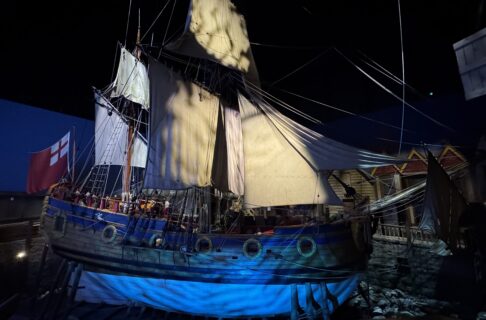Posted on: Friday June 13, 2025
by Lucy Lindell, Manitoba Museum Indigenous Scholar in Residence
Opening June 20, the day before National Indigenous Peoples Day, my solo exhibit I Belong Here will be on display in the Manitoba Museum’s Urban Corridor. Through digital art prints, the physical structures of local museums and galleries are transformed into Indigenous teachings that exist to help us live a good life.
This exhibit comes from an in-scholar residence at the Museum with Dr. Amelia Fay, Curator of Anthropology and the HBC Museum Collection. We focused on repatriation and safe museum spaces for Indigenous items.
Previous to the residency, in a cultural leadership course with Stephen Borys, I gained an understanding that historically, museum foundations were built on elitism and were meant to be an escape or distraction to bring temporary moments of freedom.
As a Métis woman learning traditional culture, my museum experiences were quite different; my visits were a time of healing and learning about my relations to Creation. Creation includes all life forms and their energies.

The Canadian Museum for Human Rights transforms into a shawl worn by a sundance ceremony helper. ©Lucy Lindell

The Manitoba Museum transforms into a representation of a sweat lodge; the mother’s womb. ©Lucy Lindell

The WAG-Qaumajuq transforms into traditional Indigenous ceremony. ©Lucy Lindell
Respectful relations to Creation continue to be harmed through colonial histories where identities were built by taking from others and going to extreme lengths to receive access to land and resources. This impacts identity, understandings of purpose, and how we think day-to-day.
I Belong Here removes colonial invalidations by sharing relatedness and ways of knowing that not everyone has had the privilege of experiencing. It shares teachings that reflect our own beauty back to us and affirms that Indigenous teachings belong in museum spaces and everyday life.
A special thank you to Dr. Amelia Fay, Dan Thomas, and the Manitoba Museum for working with me on this project.
I Belong Here will open on June 20 in the Manitoba Museum’s Urban Corridor and will be on display throughout the summer. Admission to this temporary exhibit is included in an All Attraction Pass. Manitoba Museum Members and Indigenous Peoples can access this exhibit at no charge.







































